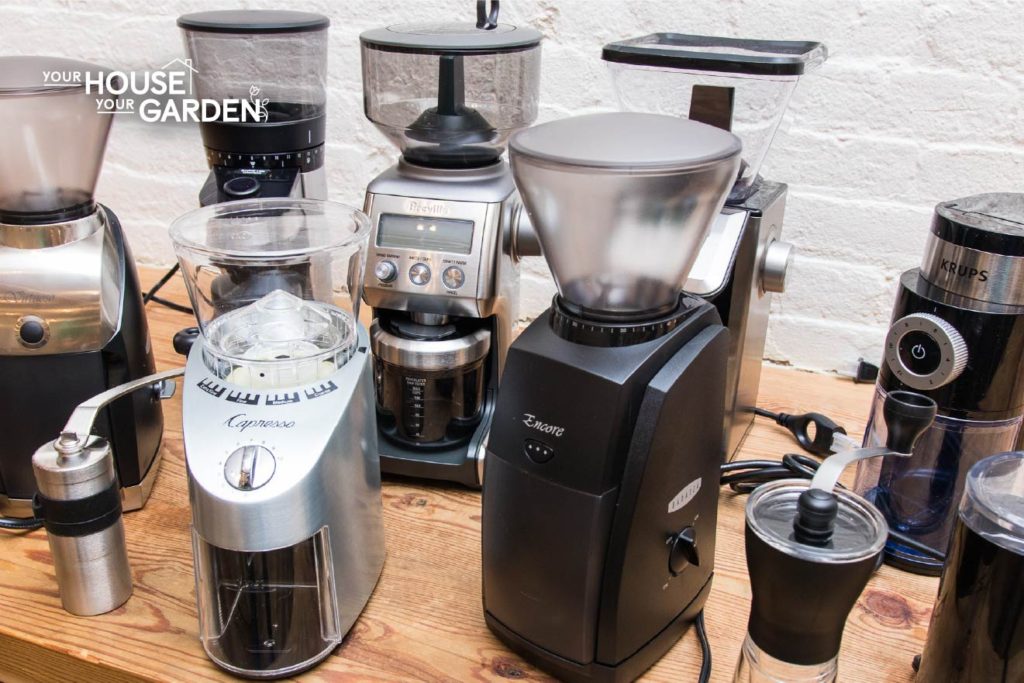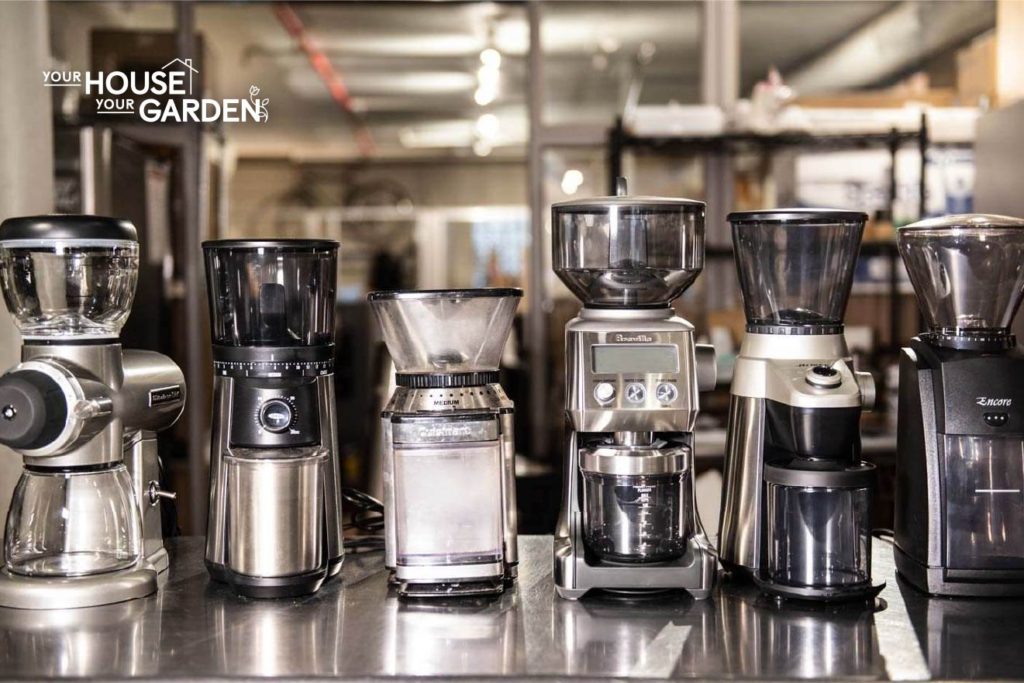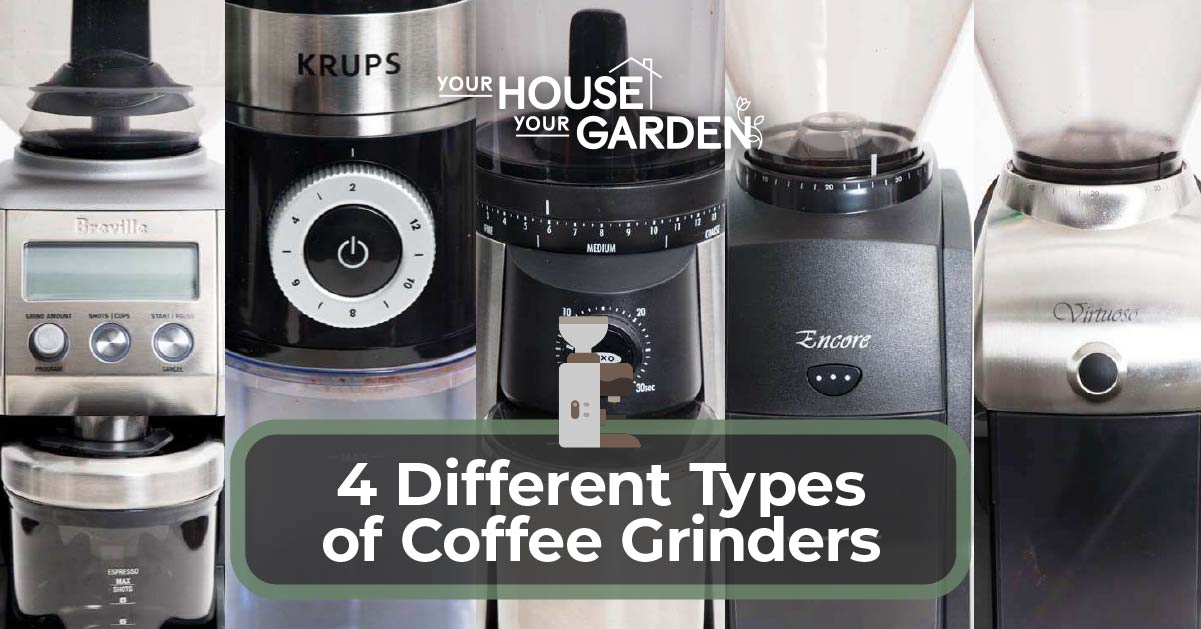There are four distinct types of coffee grinders to choose from—blade, burr, dosing, and non-dosing. Buying the best coffee grinder for your household and kitchen needs includes features, functionalities, material, brand, and Price.
It is essential to know the different coffee grinder types and the pros and cons of each to pick the best kind of coffee grinder for your kitchen. It’s also worth knowing the various uses of a coffee grinder so you know whether it’s the right one for your kitchen needs or if you might need a similar appliance instead, perhaps like a blender.
Available Types for a Coffee grinder
Blade grinder
A blade coffee grinder is a coffee grinder that revolves at high speeds to chop up the beans into smaller pieces. This process breaks down the cell walls of the bean, releasing more flavor and allowing for an even extraction when brewing.
Compared to other coffee grinders, blade grinders are cheaper, easier to find, and require less maintenance. However, they are also less precise and can create uneven grinds. This can lead to over-extraction or under-extraction of the coffee, affecting the taste.
A blade grinder is a good option if you’re looking for a cheap and easy way to grind coffee at home. Remember that more precision may be needed if you want to get the best possible taste from your coffee.
Burr grinder
A burr coffee grinder is a coffee grinder that uses two conical, or cylindrical, rotating abrasive surfaces to grind the beans. Burr grinders are typically more expensive than blade grinders, but they produce more even grind size and consistency. They also do not heat the beans as quickly during grinding, which preserves more of the coffee’s flavor and aroma.
There are two types of burr grinders: wheel burr and conical burr. Wheel burrs are less expensive than conical burrs, but they can be noisier and produce more heat, affecting the coffee’s flavor. Conical burrs are more costly, but they provide a more consistent grind size and are less noisy compared to wheel burr grinders.
The main advantage of using a burr grinder is that it produces a more even grind size. The burr grinder blades move more slowly than The beans are also ground more slowly in a burr grinder, which preserves more of their flavor and aroma. Burr grinders are also typically more adjustable than other coffee grinders to get the perfect grind size for your coffee maker.
The main disadvantage of using a burr grinder is that they are more expensive than other coffee grinders like blade grinders or dosing grinders. Burr grinders also need to be cleaned and maintained regularly, which can be time-consuming and difficult for people with busy schedules. some people. Another potential downside is that burr grinders can be pretty noisy, which may not be ideal for people with babies that nap often.some people.
Overall, if you want to get the most flavor and aroma from your coffee beans and have more control over the grind size, a burr grinder is probably your best bet. But they can be expensive, so you will need to decide whether it’s worth spending more money for better coffee.
Dosing grinder
A dosing coffee grinder is a coffee grinder that automatically dispenses the right amount of ground coffee needed to make your favorite beverage. This can be done in various ways, depending on the specific model. Some models use weight-based dispensing, while others use volume-based dispensing.
One benefit of using a dosing coffee grinder is that it can help to reduce the amount of waste generated from making coffee. For example, if you use too much ground coffee, it can go to waste. With a dosing coffee grinder, you can be sure that you are using the right amount of ground coffee, which can help to reduce waste.
Another benefit of using a dosing coffee grinder is that it can help to improve the taste of your coffee. When you use the right amount of ground coffee, it can help extract more flavor from the beans, making your coffee taste better.
There are a few disadvantages of using a dosing coffee grinder, however. These coffee grinders can be pretty expensive compared to other options like a blade grinder or a non-dosing coffee grinder. Additionally, dosing coffee grinders often require more maintenance than different grinders, which can lead to additional costs over time.
Non-dosing grinder
A non-dosing coffee grinder is a coffee grinder that does not dispense the grinds into a separate container. Instead, the grinds remain in the grinding chamber until they are needed.
The main advantage of using a non-dosing coffee grinder is that it eliminates transferring the grinds from one container to another. This reduces the risk of spillage and helps preserve the freshness of the grinds.
However, there are some downsides to using a non-dosing coffee grinder. For example, it can be more difficult to measure out specific amounts of ground coffee since you can’t use a separate container or scoop. Additionally, you’ll need to clean the grinding chamber more frequently since the grinds are not being transferred out.
Different Ways to Use a Coffee grinder?
There are many different ways to use a coffee grinder:
- Making coffee
- Making potpourri
- Grinding spices
- Grinding nuts and seeds
- Arts and crafts
Use a coffee grinder to make your morning cup of coffee, of course! Coffee grinders can also help you create other drinks and meals.
One way to use a coffee grinder is for making potpourri. Mix ground vanilla beans with dried lavender or rose petals and place them in the coffee grinder for about 30 seconds. Give the mixture a good shake, so the petals don’t stick together, then store in a glass jar.
Another way to use a coffee grinder is for making spices. Mixing your spices can save you money and give you more control over the ingredients. Place your desired spices in the coffee grinder and pulse until they’re finely ground.
You can also use your coffee grinder to grind nuts, chia seeds, flaxseeds, or wheat berries. This is a great way to add texture and nutrition to your meals or baked goods.
A coffee grinder isn’t just for making food—it’s also used in many craft projects. For example, use your coffee grinder to make homemade chalk paint. Mix equal parts of white paint and plaster of Paris, then add water to thin it out if needed.
There’s no limit to what you can do with a coffee grinder! Whether you want to make coffee, spices, or crafts, your coffee grinder is the perfect kitchen appliance for the job.
Sizes of Coffee grinders
There are different sizes of coffee grinders, depending on the type.
Blade grinders are generally smaller than other types of grinders. They have a rotating blade that moves at high speed to chop the beans into fine particles.
- Height: 4-8 inches
- Width: 2-4 inches
- Depth: 2-4 inches
- Capacity: up to 12 cups of coffee beans
Burr grinders are bigger than blade grinders and are available in various sizes. They use two cone-shaped pieces to crush the beans into finer or coarser particles, depending on how tight the burrs are screwed.
- Height: 8-16 inches
- Width: 4-8 inches
- Depth: 4-8 inches
- Capacity: up to 20 cups of coffee beans
Dosing grinders come in different sizes, but they all have an adjustable hopper that automatically dispenses the right amount of ground coffee for a single cup.
- Height: 12-18 inches
- Width: 8-12 inches
- Depth: 8-10 inches
- Capacity: up to 24 cups of coffee beans
Non-dosing grinders are generally smaller than other types and do not automatically dispense the ground coffee into a portafilter or filter. They typically have a small grinding chamber, so you may need to empty it regularly when making larger batches of coffee.
- Height: 6-10 inches
- Width: 2-6 inches
- Depth: 2-6 inches
- Capacity: up to 16 cups of coffee beans.

Blade Coffee Grinders vs. Burr Coffee Grinders
Many people have strong opinions on which coffee grinder is better: a blade or a burr coffee grinder. While both types have their merits, the latter one is better. Let’s look at how each type works and what makes them different from one another.
A blade coffee grinder has a spinning blade at the bottom of a chamber. The blade spins and grinds your coffee beans into powdery grounds as you turn it on. The pros of this type of grinder include that they are generally less expensive than burr grinders and are pretty simple to use. However, their most significant downside is that they can be somewhat inconsistent, resulting in coffee grounds of different sizes. This can impact the taste and quality of your brew.
Burr coffee grinders have two abrasive surfaces (either conical or flat) that grind and crush your coffee beans into uniform grounds as you feed them through. The main advantage of burr over blade grinders is that they produce more consistent grounds and create a better cup of coffee. However, they are generally more expensive than blade grinders and can be trickier to clean due to their small parts.
In conclusion, while both coffee grinders have their advantages and disadvantages, the burr coffee grinder is ultimately the better choice. It produces more consistent grounds and therefore creates a tastier cup of coffee. However, they are typically more expensive than their blade counterparts.
Though you’re on a budget, a blade grinder will still get the job done—be aware of its potential inconsistencies.
What Types of Coffee Can I Grind in Different Coffee Grinders?
There is a wide range of coffee grinders available on the market today. While they all share some standard features, they also have specific differences that make each suitable for grinding different types of coffee.
Let’s look at the different types of coffee that you can grind with your favorite grinder.
Regular coffee is the type of coffee that most people are familiar with, and it is typically made using a medium grind of coffee beans. This type of coffee can be used to make espresso drinks or regular drip coffees.
Flavored coffees are a type of coffee that has been infused with natural or artificial flavors. These flavors can range from fruits and spices to nuts and chocolate. Many people enjoy flavored coffees because they add an extra layer of flavor to the coffee without making it too sweet.
Espresso coffee uses finely ground coffee beans typically very dark in color. This type of coffee is brewed under high pressure, which results in a solid and flavorful cup of coffee.
Turkish coffee is a type of coffee that uses ground coffee beans very finely. This type of coffee is brewed using boiling water, resulting in a thick and creamy cup of coffee.
Cold brew coffee is a coffee made by steeping ground coffee beans at room temperature or cold water for an extended period. Because there is no heat involved in the brewing process, cold brew coffee tends to have a milder flavor than hot brewed coffee.
Various types of coffee can be ground with your favorite grinder. By understanding the differences between these coffees, you’ll be able to choose the perfect grind for your favorite type of coffee.
These various coffee types also show coffee grinders’ versatility. To maximize their functionalities, you must know the different coffee and how to use a coffee grinder.
Criteria for the Best Coffee grinder Type
When looking for the best coffee grinder for your needs, various factors are to consider. The criteria include:
- How much coffee you drink
- How much space you have in the kitchen
- Whether you prefer a manual or electric grinder
- What type of coffee you like to drink
- How much you have in your budget
How much coffee you drink will help determine the grinder size you need. If you only drink one cup a day, a small personal grinder will suffice. However, if you make coffee for multiple people or drink several cups a day, you will need a larger grinder.
When buying a coffee grinder, how much space you have in the kitchen is another factor to consider. If you are limited on counter or cabinet space, then a smaller grinder that fits in easily might be right. However, if you have the room to spare and want maximum functionality, then a larger grinder with more features may be what you need.
Do you want a manual or electric grinder? Manual grinders are typically more affordable and require less counter space. Electric grinders are often more expensive but will save you time in the grinding process.
What type of coffee do you like to drink? If you prefer espresso, you will need a grinder to create finely ground coffee. On the other hand, if you prefer a coarse grind, you will want to look for a grinder that can produce larger coffee grounds.
Ultimately, no one “right” coffee grinder is perfect for everyone. The best choice will depend on your unique needs and preferences. By considering these criteria, you can narrow down your options and find the best coffee grinder for you.
Coffee grinder and Safety
Coffee grinders are relatively safe to use in the kitchen, primarily when used correctly.
While coffee grinders can be a convenient way to prepare coffee, they pose some safety hazards. The blades inside the grinder are very sharp and should be handled with care to avoid injury. Some coffee grinders have finer settings that can get stuck in your skin if you are not careful.
Be sure to follow the instructions carefully when using a coffee grinder, and always use caution when handling the blades.
Coffee grinder and Price
Coffee grinders can range from around $20 to over $400. The type of grinder, the brand, and the features offered are essential factors to consider when determining how much to spend. Design and materials used can also affect the Price.
Blade grinders will generally be the most affordable option, while burr grinders will be on the more expensive side.
One of the main factors that will affect the price of a coffee grinder is the type of grind it offers. Blade models are typically very cheap, but they only provide a coarse grind and can create inconsistent grounds. They may not be ideal for brewing espressos or other specialty coffee drinks. Burr grinders, on the other hand, can provide a more uniform grind and will usually offer a more fantastic range of grind settings, making them more versatile but also more expensive.
The brand is also an essential factor to consider in coffee grinders. Some of the most popular brands, such as Cuisinart and Krups, will offer more affordable models, while higher-end brands like Baratza and Rancilio will be more expensive.
The features that a grinder offers can also affect its Price. For example, grinders with built-in scales or timers tend to be pricier than those without these features.
With so many options available, there will be a coffee grinder out there to suit every budget.

Lifespan of Different Coffee grinder Types
Coffee grinders often last for 2 to 7 years on average. Here’s a look at how long each type of grinder typically lasts:
- Blade grinders: 2-3 years
- Burr grinders: 4-5 years
- Heavy-duty burr grinders: 6-7 years+
- Dosing grinders: 6-7 years+
- Non-dosing grinders: 6-7 years+
Coffee grinders have many moving parts that are subject to wear and tear over time. Blade grinders, consisting of a spinning blade on the bottom of a grinding bowl, tend to last for 2-3 years due to constant exposure to heat and friction.
Burr grinders have the edge over blade grinders when it comes to lifespan. This is because burr grinders are designed to last longer and can handle more wear and tear. Heavy-duty burr grinders, in particular, are built to withstand years of use, making them an excellent investment for serious coffee drinkers.
Overall, coffee grinders can last for several years if properly maintained and used. Regular cleaning and maintenance are essential for keeping the machine in good working order. Additionally, if you want to extend the lifespan of your coffee grinder even further, be sure to use it only for grinding coffee beans and not other items that might damage or wear out the blades.
Coffee grinder Types and Food Taste
When it comes to coffee, many factors can affect the taste. The coffee bean, the roast, the grind, and the coffee grinder are all crucial factors. Each of these can have a significant impact on how your coffee tastes.
Blade grinders use a metal blade to chop the coffee beans into small pieces. They are inexpensive and easy to use, but they can result in inconsistent grinds that may not taste as good.
Burr grinders use two revolving surfaces (stationary and moving) to crush the coffee beans into uniform pieces. They are more expensive than blade grinders, but they produce a more consistent grind that can result in better-tasting coffee.
Dosing grinders dispense a certain amount of coffee each time you use them, ideal for making pour-over coffee. They are more expensive than blade grinders but may be worth the investment if you enjoy making pour-over coffee often. Coffee produced by dosing grinders tastes like it was made with a commercial-grade coffee grinder.
Non-dosing grinders do not dispense a set amount of coffee each time you use them. This means you’ll have to measure out the coffee beans yourself, which can be more time-consuming. However, non-dosing grinders are usually more affordable than dosing grinders. Coffee produced by non-dosing grinders has a rich and premium taste.

